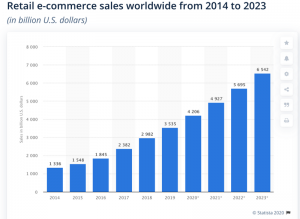 Dealing with ROI can sometimes feel like being stuck in the middle of the ocean: deep, confusing, and ever-changing.
Dealing with ROI can sometimes feel like being stuck in the middle of the ocean: deep, confusing, and ever-changing.
It’s even worse when you’re trying to work out the return on interest of something really complex and niche, like, say, video.
But just because it seems confusing doesn’t mean it’s not worth doing.
It’s actually easier than you think to track the ROI of your video content and get a great return on your investment.
That’s why 52% of marketing professionals worldwide say that video has the best ROI of all content types.
I’m going to show you how to measure your video ROI, and then I’m going to explain 5 ways to get better results from the investment you do make in video. So let’s get going.
5 Fundamentals of Video Content Planning
Learn the key steps to planning engaging & effective video content.
Packed full of our expert advice on how to create a video strategy, set SMART objectives, and generate the best possible video ROI.
How to Calculate Your Video ROI
We’ll start with the basics. Here’s the classic formula used to calculate ROI:

When working out the ROI of video, you need to total up all the gains and costs of that content and then run it through the equation.
For the most accurate results you should count the ‘gain’ of your video content as whatever your objectives were for that piece of content. For example, if you created an educational video to generate leads on your site then the gain for that video would be the number of leads you managed to generate in a set period of time (assigned a monetary value according to your lead value or lead conversion rate).
But the gains and costs of your video content can be almost anything. Here’s a list of some of the most common when it comes to videos:
Investment Gains for Video
| Investment Costs for Video
|
Now we know how to calculate video ROI, how do we make sure we’re getting good results?
To improve the ROI of your videos you need to either reduce their cost or increase their gain.
Because we believe the best results come from investing in great video content (we’re a little biased), we’re going to share with you our 5 most effective tips to boost the gains of your videos.
5 Ways to Improve the ROI of Your Video Content
1. Really Understand Your Audience
There’s no way to create good video content without first understanding your target audience.
Remember that your videos aren’t really about you at all — they’re about your audience and their needs. This audience could be your customers or your employees, but the fact still applies.
Unless you consider how to provide genuine value to your audience, your video content won’t be useful for or engaged with by them. And without initial engagement, there’s no chance of getting a good return on your investment in video.
So take the time to get to know your target audience and let this inform both your creation and distribution strategy.
2. Create a Distribution Strategy
You’ll never get a good ROI for your video content if it isn’t watched in the first place. So you need to think about your target audience, where they spend their time, and how to ensure your video reaches them on the channels they use.
By effectively distributing your video content, whether externally or internally, you’ll make sure your video gets watched, engaged with, and ultimately gets results. This is the foundation of future success — all the goals you want to achieve with video begin with your content actually being seen. And the more of your target audience watch your videos, the better ROI you’ll get.
Be sure to spend time on planning where you’ll use and share your video content, from uploading it on social media to screening it for your team.
3. Use Call-to-Actions
Once you’ve got to grips with your audience and how to reach them, you need to think about what you want them to feel, think and do after watching your video.
If you want viewers to take action once they’re done with your video content (and you most likely do) then make sure you include a Call-to-Action, or CTA, at the end of your video. Don’t leave your audience’s actions up to chance. Give them direction by letting them know what you recommend they do next, whether that’s visiting your site, filling out a form or putting an item in their basket.
By guiding your viewers towards your desired action, you’ll be able to directly track and improve the effectiveness of your videos. And that, in turn, will increase ROI.
4. Repurpose and Reuse Your Videos
You repurpose other kinds of content, so why not repurpose your video content too?
To get maximum ROI from your videos, don’t just use them once. Reuse them across different channels and in different ways. This will depend entirely on the type of video content you produce, but could involve slicing your video up into smaller parts and sharing on social media, writing blog posts around your video, or reusing footage in other places.
By reusing your video content you’ll get more return from videos you’ve already made, meaning you’ll spend less on creating new videos. And as long as you always keep in mind your audience and what they find useful, the options for repurposing your video content are almost limitless.
5. Track Your Results
Lastly, you should always keep track of how your video content is performing. This will allow you to work out your video ROI more effectively, and plan for better results in the future.
There are lots of video metrics to consider, but at the very least you’ll want to measure:
- Play rate: A measure of whether the video was viewed once it loaded. For example, a 70% play rate means your video was watched 7 out of 10 times it loaded. A higher play rate means your video is more relevant on the channel where it’s displayed, and viewers are more attracted to clicking play.
- Average engagement: This is the average of how much of your video viewers watched in total. An average engagement of 85% means, on average, viewers watched 85% of your whole video. The higher your engagement, the longer your audience is watching and finding your message useful and/or enjoyable.
- Click-through rate: A percentage of how many viewers of your video clicked on the Call-to-Action. If your video click-through rate is 67%, then 67% of all watchers clicked on your CTA. The higher your click-through rate, the more viewers are taking your desired action after the video ends.
But don’t get lost in your statistics. Continuous improvement is the goal here. Use them to learn about what went right or wrong with your latest video, and how you can make even better video next time. By doing so you’ll be improving the gains, and therefore ROI, of your video content.
Roundup: Smart Video Makes Good ROI
Now you should know how to measure your video ROI and steps you can start taking immediately to boost it.
At the end of the day, improving the ROI of your video content is all about creating smarter video. If you can plan well, appeal to your audience and distribute in the right places, you’ll be well positioned to create effective videos that achieve your goals and provide a great return on investment.
Use our tips to navigate the sometimes uncertain waters of ROI and achieve bigger and better things with video. Good luck!
5 Fundamentals of Video Content Planning
Learn the key steps to planning engaging & effective video content.
Packed full of our expert advice on how to create a video strategy, set SMART objectives, and generate the best possible video ROI.
Digital & Social Articles on Business 2 Community
(114)









